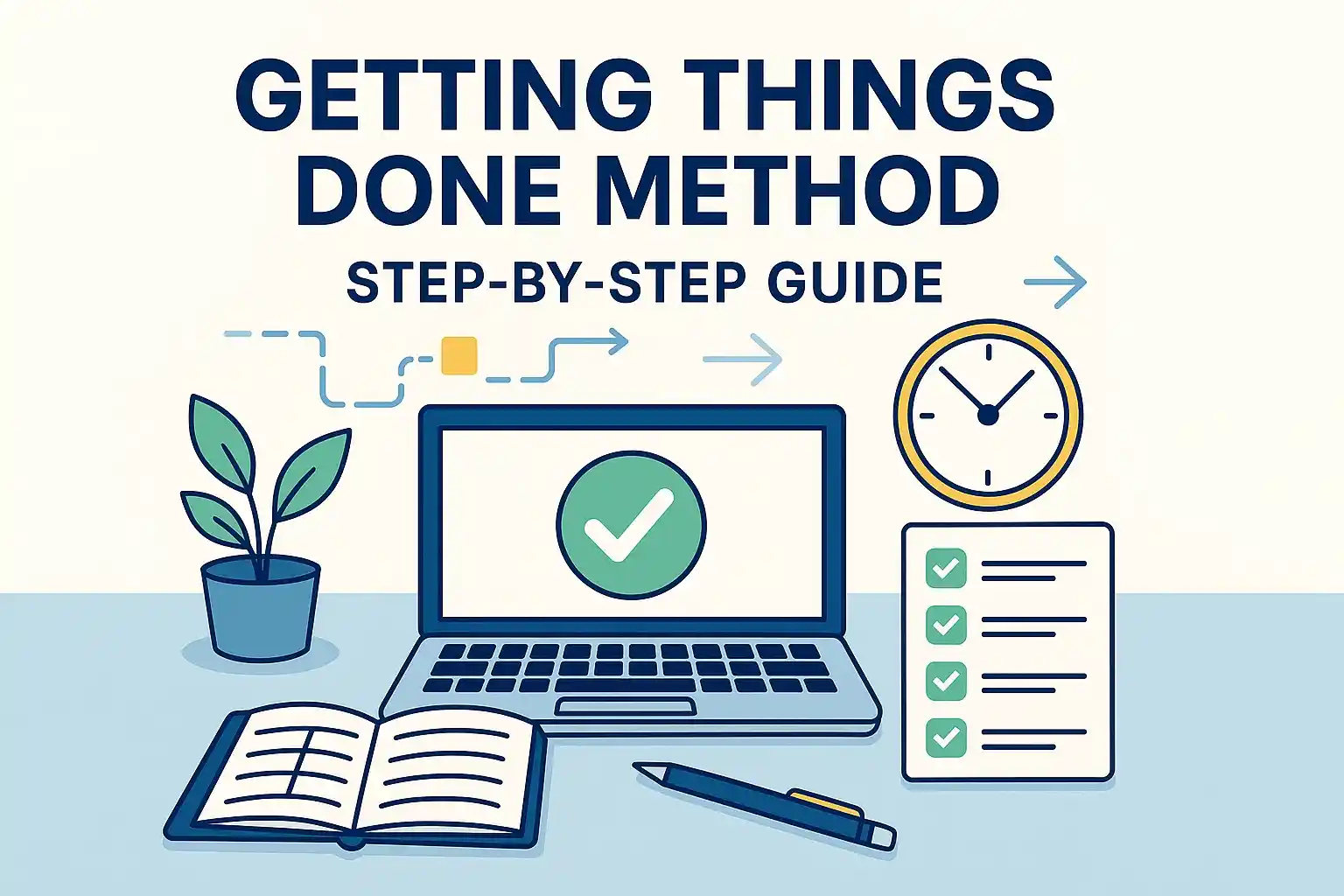

Feeling overwhelmed by endless to-do lists and constant mental clutter? You’re not alone. Recent studies reveal that nearly half of employees feel productive less than 75% of the time, with many citing frequent interruptions and ineffective meetings as major culprits. This begs the question: how do you get things done? Enter the Getting Things Done method, also known as the GTD method — a proven framework developed by productivity expert David Allen.
GTD isn’t just another trend; it’s a practical system trusted by professionals, entrepreneurs, students, and high-performers worldwide.
This step-by-step guide will walk you through the GTD meaning, method, showing you how to regain control, reduce overwhelm, and unlock your full potential — one organized action at a time. Ready to reclaim your focus? Let’s delve right in.
The Getting Things Done method is a productivity system created by David Allen that helps you capture, clarify, and organize tasks to reduce mental clutter and boost efficiency. At its core, GTD is about getting everything out of your head and into a trusted system so you can focus on taking action, not just remembering what to do.
Unlike rigid time-blocking techniques, GTD method offers a flexible, stress-free approach that adapts to your lifestyle. It’s especially valuable for professionals, entrepreneurs, and students juggling multiple responsibilities and seeking clarity in a fast-paced, distraction-heavy world.
Now, that have you have a clear idea of getting things done meaning, let’s take a look at how this system works in the next section.
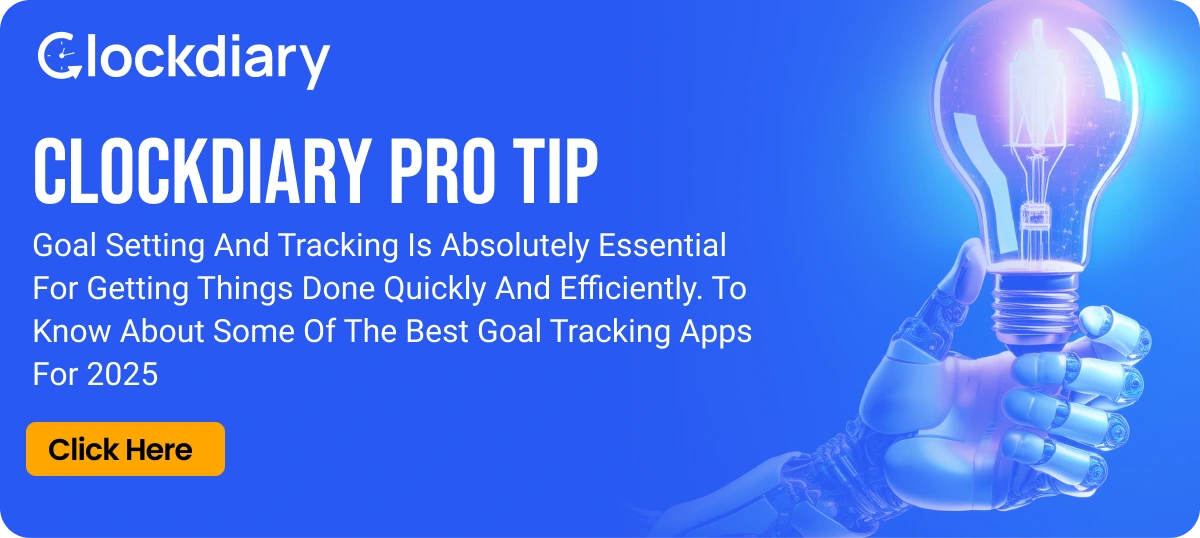
The Getting Things Done method is built around five key steps that help you manage tasks, reduce stress, and boost clarity. By breaking down your workflow into structured stages, getting things done outline enables you to move from chaos to control.
Let’s explore how each step of the getting things done method explained works — with real-life examples for context.
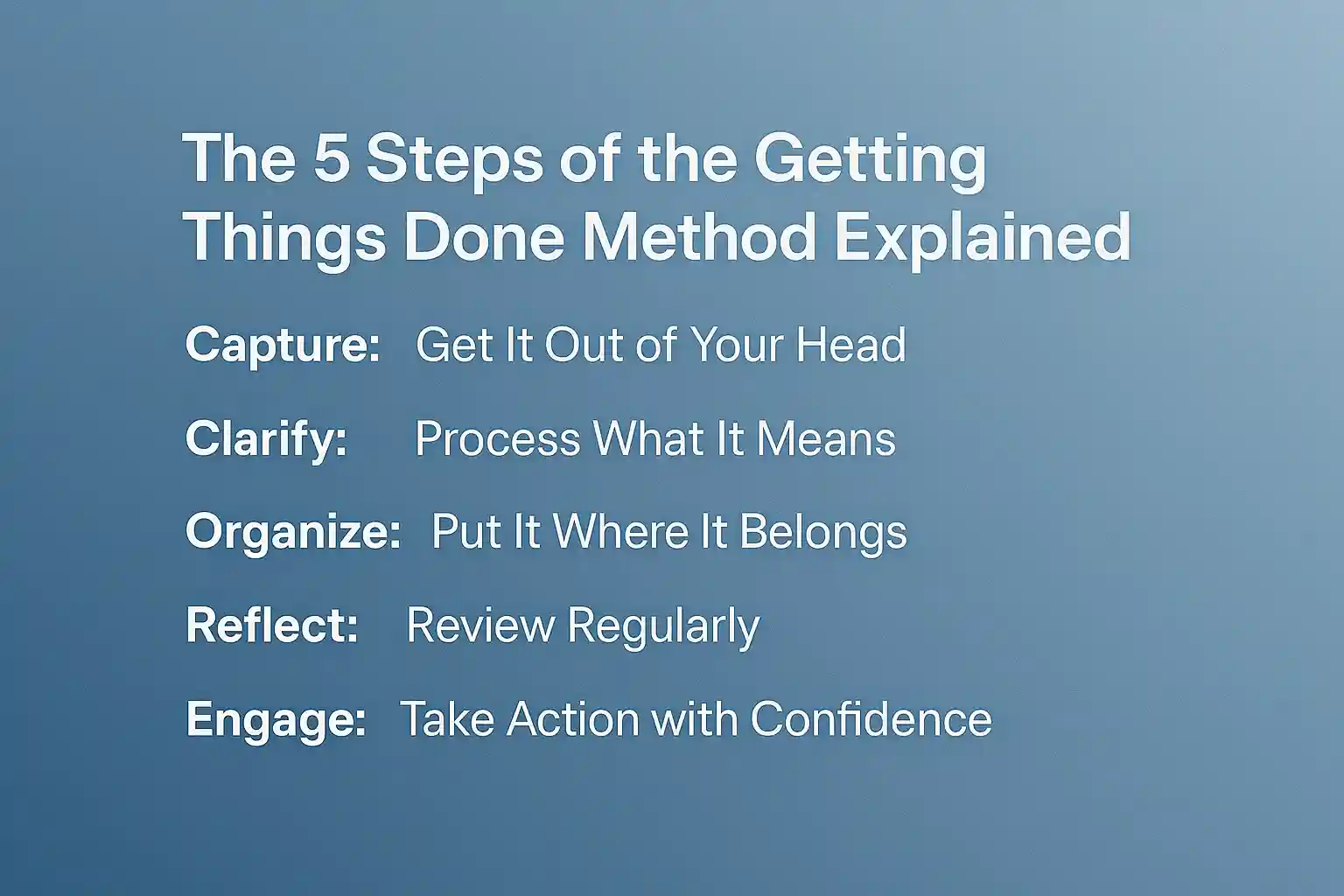
“Your mind is for having ideas, not holding them.” — David Allen.
The first stage of David Allen’s getting things done method is “Capture.” Collect every task, idea, or commitment into an external system.
Instead of relying on memory (which is unreliable), David Allen getting things done starts with capturing everything that demands your attention.
Examples of Capture Tools:
Example:
You’re in a meeting and remember you need to schedule your annual health checkup. Instead of letting it float around in your mind, you jot it down in your task manager app like Clockdiary.
Decide what each captured item actually requires.
Once items are collected, you determine whether each one is actionable. If yes, define the next step. If not, either archive, delete, or file it for reference.
Clarification Categories:
Example
“Update website” isn’t a task — it’s a project. The next actionable step might be: “Email designer about homepage layout.”
“For every minute spent organizing, an hour is earned.” — Benjamin Franklin.
Categorize tasks and projects into meaningful lists or folders. A good task management software can come in handy here.
You’ll place clarified items into systems such as:
Example
“Pick up dry cleaning” goes on your Next Actions list under the “Errands” context. “Client proposal due Friday” goes on your Calendar.
Here’s how the Getting Things Done flowchart looks like:
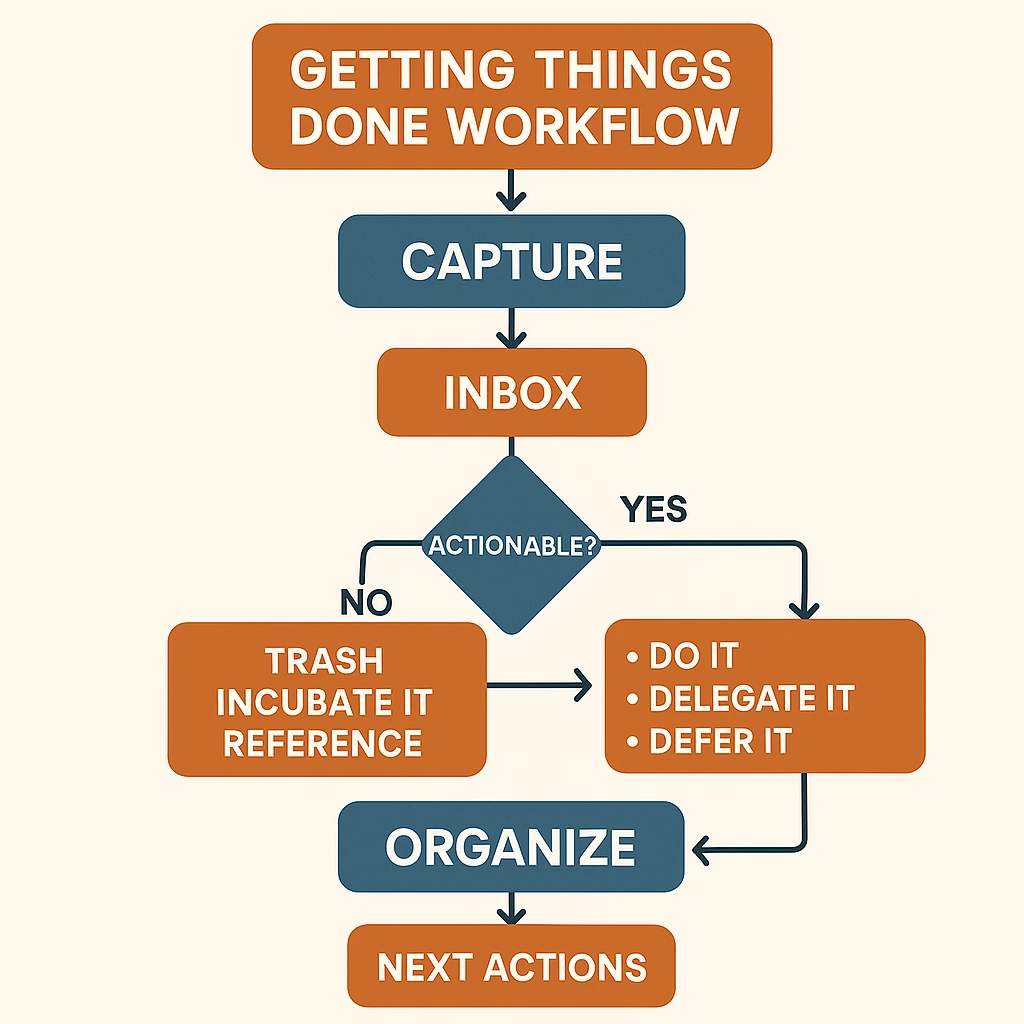
“In the middle of difficulty lies opportunity.” — Albert Einstein.
Stay in control and aligned with your goals.
The Weekly Review is the backbone of getting things done method of time management. It helps you:
Example
Every Friday afternoon, you review your Projects list, check off what’s done, and plan for the week ahead — just like a CEO doing a boardroom check-in with their tasks.
“Action is the foundational key to all success.” — Pablo Picasso.
Work from your lists with clarity and purpose.
Now that everything’s organized, you can choose what to do based on:
You can make use of the rapid planning method for better results.
Example
Stuck waiting in line? Open your phone and knock off a few calls from your “Phone” context list.
By following these five steps, the getting things done method David Allen helps you shift from reactive busyness to intentional productivity — and that’s how real progress happens. So, with a clear idea of what is GTD and its working mechanism, now let’s take a look at the best tools for implementing the GTD method in the next section.
Implementing the Getting Things Done method successfully hinges on using tools that support capturing, clarifying, organizing, reflecting, and engaging. While GTD is tool-agnostic, certain digital and analog systems make it significantly easier to build and maintain your productivity system.
Below are some of the best tools to help you stay organized and execute tasks efficiently.
Todoist
A popular task manager that aligns seamlessly with GTD principles.
Key GTD-friendly Features:
Notion
A flexible, all-in-one workspace that works well for custom GTD setups.
Key GTD-friendly Features:
Asana
Designed for teams but equally useful for solo professionals managing complex projects or multiple projects at once.
Key GTD-friendly Features:
Basecamp
A streamlined tool for teams that value simplicity.
Key GTD-friendly Features:
Evernote
Ideal for storing reference materials and non-actionable content.
Key GTD-friendly Features:
Alternatively, you can also check out for note-taking browser extensions for more options.
Clockdiary
Primarily a time tracking tool, but highly effective for GTD when paired with task management.
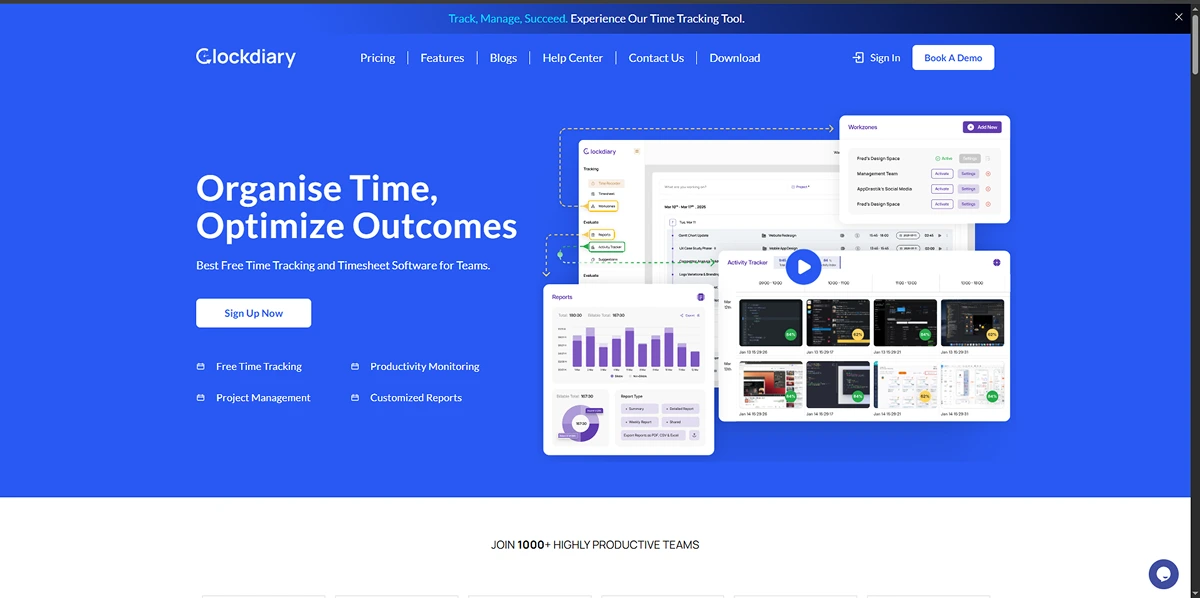
Why It Stands Out for GTD:
Clockdiary getting things done method app bridges the gap between planning and execution — one of the biggest hurdles for new GTD users.
Alternatively, you can simply use a pen and paper to stay focused and intentional.
Paper Systems
Personal Kanban
Hipster PDA
Whehter you prefer sleek digital apps or tactile analog systems, the key to successful getting things done method for ADHD implementation is consistency. Choose tools that are user-friendly and fit your workflow — not the other way around.
To help you implement the Getting Things Done method more easily and consistently, we’ve created two powerful, free resources: an editable Getting Things Done Template and a Weekly Review Checklist. These tools are designed to support your daily and weekly workflows, reduce stress, and boost your overall productivity — whether you’re just starting out with GTD or refining your current system.
This fully editable GTD template is ideal for both beginners and experienced users. It’s formatted to guide you through each of the five GTD steps — Capture, Clarify, Organize, Reflect, and Engage — so you don’t miss a beat.
Key features include:
✅ Capture Section: Brain dump area to quickly jot down anything that has your attention.
✅Clarify Prompts: Helps you determine whether each item is actionable and if so, what the next action is.
✅ Organize Columns: Includes lists like Next Actions, Projects, Waiting for, Someday/ Maybe, and Reference.
✅ Context Tags: Group tasks by context (e.g., @Home, @Work, @Calls) for easier filtering.
✅ Priority Filters: Identify high-impact tasks that deserve your attention first. You can use the Eisenhower Matrix technique to prioritize tasks based on urgency and importance.

⬇️ Download Getting Things Done Method Template (Google Sheets)
⬇️ Download Getting Things Done Method PDF Template
You can also avail of free time blocking templates for better time management and get things done faster and efficiently.
The Weekly Review is the cornerstone of a successful GTD system. This printable checklist walks you through a structured reflection process to help you regain clarity, clean up loose ends, and set priorities for the coming week.
Checklist includes steps to:
✅ Empty all inboxes (email, physical, digital)
✅ Review your calendar (past and upcoming events)
✅ Assess project lists and next actions
✅ Update and organize task lists
✅ Reflect on wins and areas for improvement
✅ Re-prioritize tasks for the week ahead
You can print it out, keep it on your desk, or upload it into your note-taking app for digital use. It’s a simple yet effective tool to ensure you stay grounded and in control.
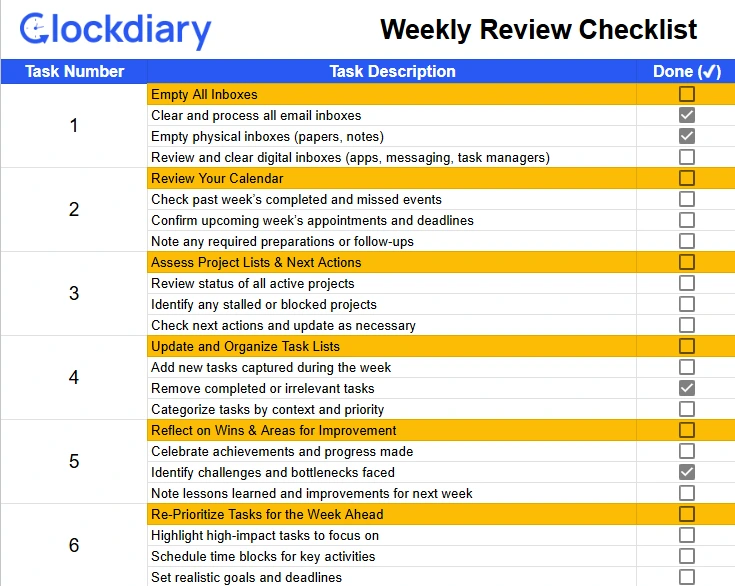
⬇️ Download Weekly Review Checklist Google Sheets
⬇️ Download Weekly Review Checklist PDF
Use them regularly, and you’ll be amazed at how much more organized, focused, and productive your days become.
While the GTD Getting Things Done method is incredibly effective, it’s not without challenges—especially when first getting started. Let’s break down the most common roadblocks people face and how you can overcome them to fully benefit from the GTD system.
The Challenge:
Many users try to build the “perfect” setup with too many tools, tags, and categories. This often leads to overwhelm.After all, “Simplicity is the ultimate sophistication.” — Leonardo da Vinci.
Solution:
Keep it simple. Start with basic lists: Next Actions, Projects, Waiting For, and Someday/Maybe. Use one or two tools (like Clockdiary) and refine only after the system feels natural. A PERT chart can also prove to be a boon here.
Example:
Instead of creating 12 project folders and custom tags, start with 3 core lists and a calendar.
The Challenge:
Forgetting to capture tasks consistently causes things to slip through the cracks.
Solution:
Make capturing a habit. Keep tools within arm’s reach: a pocket notebook, a notes app, or even voice memos.
Example:
Set a phone shortcut to open your notes app instantly when an idea pops up.
The Challenge:
“A goal without a plan is just a wish.” — Antoine de Saint-Exupéry. Tasks like “Plan event” stay untouched because they’re too vague.
Solution:
Always define the very next physical action. That reduces decision fatigue and gives you a clear starting point.
Example:
Instead of “Plan birthday,” write “Call a restaurant to check availability.”
The Challenge:
With a long “Next Actions” list, it’s easy to succumb to procrastination and avoid high-impact tasks in favor of easier ones.
Solution:
Use the GTD decision criteria: context, time, energy, and priority. Set a daily top 3 to stay focused.
Example:
Use tags like “low energy” or “High Priority” to match tasks with your current capacity.
The Challenge:
“Success is the sum of small efforts, repeated day in and day out.” — Robert Collier
The system falls apart if you don’t review it regularly.
Solution:
Commit to a Weekly Review. It’s your reset button.
Example:
Block 30 minutes each Friday to clean up inboxes, update projects, and plan next week’s actions.
The Challenge:
Large goals feel overwhelming and stall progress.
Solution:
Break every project into smaller, clearly defined next actions.
Example:
“Launch blog” becomes “Buy Domain”, “Set Up WordPress”, “Write First Post.”
The Challenge:
“Change is hard at first, messy in the middle, and gorgeous at the end.” — Robin Sharma.
Switching from reactive habits to a structured system can feel unnatural.
Solution:
Start small. Build one GTD habit at a time — begin with capturing, then move on to weekly reviews.
Example:
Use habit trackers with reminders feature like Clockdiary until GTD routines become second nature.
Thus, we can say that David Allen getting things done method isn’t being about perfect — it’s about progress. With the right mindset and some tweaks, anyone can make the system work for them.
The Getting Things Done Method isn’t just another productivity trend — it’s a practical framework that delivers real, measurable benefits. Whether you’re managing your own responsibilities or leading a team, getting things done flowchart creates clarity, focus, and momentum in both personal and professional life.
Here’s how individuals can benefit from implementing the GTD method:
“The mind is everything. What you think you become.” — Buddha
By moving ideas and tasks out of your head and into a trusted system, GTD frees up mental bandwidth. This reduces the overwhelm that comes from trying to remember everything at once.
For instance, instead of constantly thinking “Don’t forget to email Susan,” you’ve already captured it in your system, allowing your brain to relax.
Multitasking reduces productivity by 40%, highlighting the importance of focused task management and measuring productivity effectively.
Get things done GTD encourages you to identify clear next actions and categorize tasks by context and urgency. This makes it easier to focus on what matters most in the moment.
For example, you can immediately see what you can do in 10 minutes between meetings, rather than wasting time figuring it out.
“Don’t watch the clock; do what it does. Keep going.” — Sam Levenson
With your tasks organized and your priorities clear, you’ll spend less time planning and more time doing. GTD reduces decision fatigue, helping you act faster and with more confidence.
Knowing your top priorities each day helps you make meaningful progress instead of bouncing between low-value tasks.
A reliable system provides peace of mind. You no longer need to worry about what you might be forgetting — your system holds it for you.
Instead of losing sleep over your growing to-do list, you trust that your weekly review will keep everything on track.
“In any moment of decision, the best thing you can do is the right thing.” — Theodore Roosevelt
Getting things done methodology separates planning from doing, allowing you to think clearly when organizing tasks and act decisively when it’s time to execute.
For example, during your weekly review, you evaluate projects strategically — not reactively — making smarter decisions about where to focus.
By aligning tasks with available time and energy levels, GTD helps you use each window of time more effectively. In fact, proper time management increases workplace efficiency by 35%, underscoring the value of structured task planning.
For instance, if you have 30 minutes and low energy, you can quickly find matching tasks and make the most of that window.
Here’s how teams can benefit from the GTD method:
In the words of Hellen Keller, “Alone we can do so little; together we can do so much.”
When everyone uses a shared GTD flowchart, communication becomes clearer and more actionable.
Team members can capture and delegate tasks precisely, thereby reducing confusion and follow-ups.
Breaking large projects into next actions ensures steady progress and easier tracking of milestones. This, in turn, leads to the formation of a high-performing team.
For example, instead of vague updates like “Working on it,” teammates share specific completed steps.
Clearly assigned next actions make it easy to see who’s responsible for what — and whether it’s progressing.
For instance, a “Waiting For” list makes it simple to track delegated tasks and follow up effectively.
By reviewing and aligning priorities regularly, teams stay focused on strategic goals rather than getting lost in day-to-day noise.
For example, weekly reviews sync team efforts with broader business objectives, keeping everyone rowing in the same direction.
Thus, it can be safely said that getting things done method transforms scattered efforts into structured momentum — for individuals and teams alike.
Implementing the getting things done method is less about perfection and more about building sustainable habits that help you reduce overwhelm and increase focus. Here are some powerful tips for successfully adopting the GTD method , especially for busy professionals, entrepreneurs, and productivity seekers.
Choose tools (digital or analog) that fit your lifestyle. Whether it’s dedicated getting things done method app like Clockdiary or list managers like Todoist or maybe even a paper notebook, the best system is the one you’ll actually use.
“Perfection is the enemy of progress.” — Winston Churchill
GTD isn’t about creating the perfect “workflow” from day one. Start small, experiment, and improve as you go.
Implementing get things done method is a behavior shift. It takes time to turn capturing, clarifying, and organizing into second nature. Stick with it.
Use apps like Clockdiary or Notion to automate repetitive tasks, reminders, and recurring reviews. Let technology support your mental clarity.
“You will never reach your destination if you stop and throw stones at every dog that barks.” — Winston Churchill
Create a distraction-free zone when engaging with tasks. Use website blockers, silence notifications, and protect your deep work hours.
Always ask: What’s the next physical, visible step I can take? This keeps tasks actionable instead of vague or overwhelming.
Example:
“Plan marketing campaign” → “Email designer for banner concept”
Not everything needs your direct attention. Use a “Waiting For” list to track delegated items and follow up when needed.
The Weekly Review is the heartbeat of getting things done method summary. Reassess tasks, update lists, and ensure nothing’s slipping through the cracks.
Choose what to work on based on context, energy, and priority. Don’t just pick the easiest task — pick the right one.
Celebrate wins and review what’s working. Reflection builds confidence and keeps motivation high.
“Adapt what is useful, reject what is useless, and add what is specifically your own.” — Bruce Lee
Your GTD system should evolve with your life. Periodically reassess your tools, lists, and habits for continued alignment.
If a task takes less than two minutes, do it immediately. It’s a fast and effective way to stay on top of small tasks.
Pair GTD with 25-minute Pomodoro sessions for focused sprints. This helps you stay engaged without burning out.
Use tools like the Eisenhower Matrix to distinguish what’s urgent vs. important, ensuring you stay focused on high-impact work.
Successfully implementing getting things done method is about building a system that feels natural, not forced. Start simple, stay consistent, and tweak as needed — progress will follow.
The true power of the Getting Things Done method shines when applied to everyday situations. Here are real-life getting things done method examples across daily tasks, work projects, and personal goals—each following the five GTD steps: Capture, Clarify, Organize, Reflect, and Engage.
Grocery Shopping
House Cleaning
Personal Errands
GTD Project Planning Example
Email Management
Meeting Preparation
Learning A New Skill
Starting A New Hobby
Personal Growth
By applying GTD’s five steps to real-world tasks, you can turn chaotic days into streamlined action—one small step at a time.
Clockdiary isn’t just a time-tracking app—it’s a powerful productivity tool that complements the Getting Things Done method from start to finish. Whether you’re an entrepreneur managing billable hours, a team leader coordinating deliverables, or a student juggling assignments, Clockdiary brings structure and insight to how you spend your time.
Here’s how it supports every phase of the getting things done workflow chart:
Clockdiary brings visibility, accountability, and rhythm to your GTD practice. By integrating time awareness into your productivity system, it ensures you’re not just planning well—but actually getting things done, every single day. Get in touch with us to integrate this supremely engineered getting things done method app into your personal and professional life and see the difference for yourself.
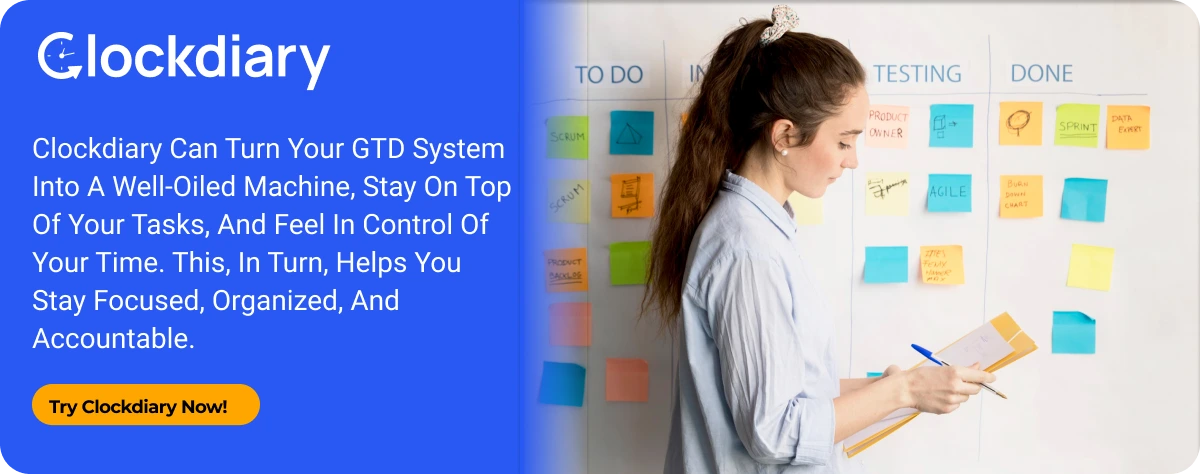
Frequently Asked Questions About The GTD Method:
GTD stands for Getting Things Done, a productivity methodology developed by David Allen that helps individuals manage tasks, reduce mental clutter, and stay organized. It focuses on capturing everything that demands your attention and turning it into clear, actionable steps.
The first step in the Getting Things Done methodology is Capture, which involves collecting all tasks, ideas, and commitments from your mind into a trusted external system. This clears mental clutter and ensures nothing important slips through the cracks.
The five steps of the GTD method are: Capture, Clarify, Organize, Reflect, and Engage. These steps help you collect all your tasks and ideas, process them into actionable items, structure them efficiently, review them regularly, and take focused action.
The strategy of Getting Things Done is to move tasks and commitments out of your mind and into a trusted system, allowing you to focus on taking clear, deliberate action. By breaking projects into manageable steps and reviewing them regularly, GTD helps you stay organized, reduce stress, and make meaningful progress.
Yes, you can use the Routine app for GTD as it supports task management, calendar integration, and daily planning — all essential for implementing the method effectively. Its ability to capture tasks quickly, set priorities, and review your schedule aligns well with the GTD workflow.
However, if you are looking for a Routine app alternative, dedicated getting things done method app Clockdiary would be your best bet.
Getting Things Done is important because it helps reduce mental clutter, improves focus, and increases productivity by providing a clear system for managing tasks and responsibilities. It empowers individuals to work more efficiently, make better decisions, and feel less overwhelmed in both personal and professional life.
The best way to get things done is to break tasks into clear, actionable steps and prioritize them based on importance and context. Using a structured system like GTD helps maintain focus, reduce overwhelm, and ensure consistent progress toward your goals.